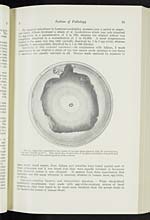Alexander Fleming (1881-1955)
Lysozyme: President's address
5
Section of Pathology
75
By repeated subculture in lysozyme-containing material over a period of ninety-
one weeks, Allison developed a strain of M. lysodeikticus which was only dissolved
by egg- white in a concentration of 1 in 800, whereas the original culture was
completely dissolved in a concentration of 1 in 64,000. A fæcal streptococcus
treated in the same way was only partially dissolved by 1 in 5 egg-white, whereas
originally it was completely dissolved by a 1 in 800 dilution.
Specificity of this acquired resistance.—In conjunction with Allison, I made
observations to see whether a strain of the test coccus made resistant to one tissue
or secretion was equally resistant to all. Strains made resistant by exposure to
tears, tonsil, nasal mucus, liver, kidney, and intestine were tested against each of
these substances and it was found that they were equally resistant to lysozyme
from whatever source it was obtained. It seemed from these experiments that
lysozyme was the same wherever it occurred, whether in human tears, egg-white,
or turnip.
[NLS note: a graphic appears here – see image of page]
FIG. 2.—Eggwhite embedded in the centre of an agar plate planted with M. lysodeikticus.
Six days’ growth at 37° C. This shows the central area of complete inhibition of growth and
subsequent lysisof the central portion of the culture.
Lysozyme-resisting bacteria and intracellular digestion. — When whole-blood
bactericidal experiments were made with egg-white-resistant strains of fæcal
streptococci, they were found to be much more resistant than the parent strain to
the bactericidal power of human blood.


